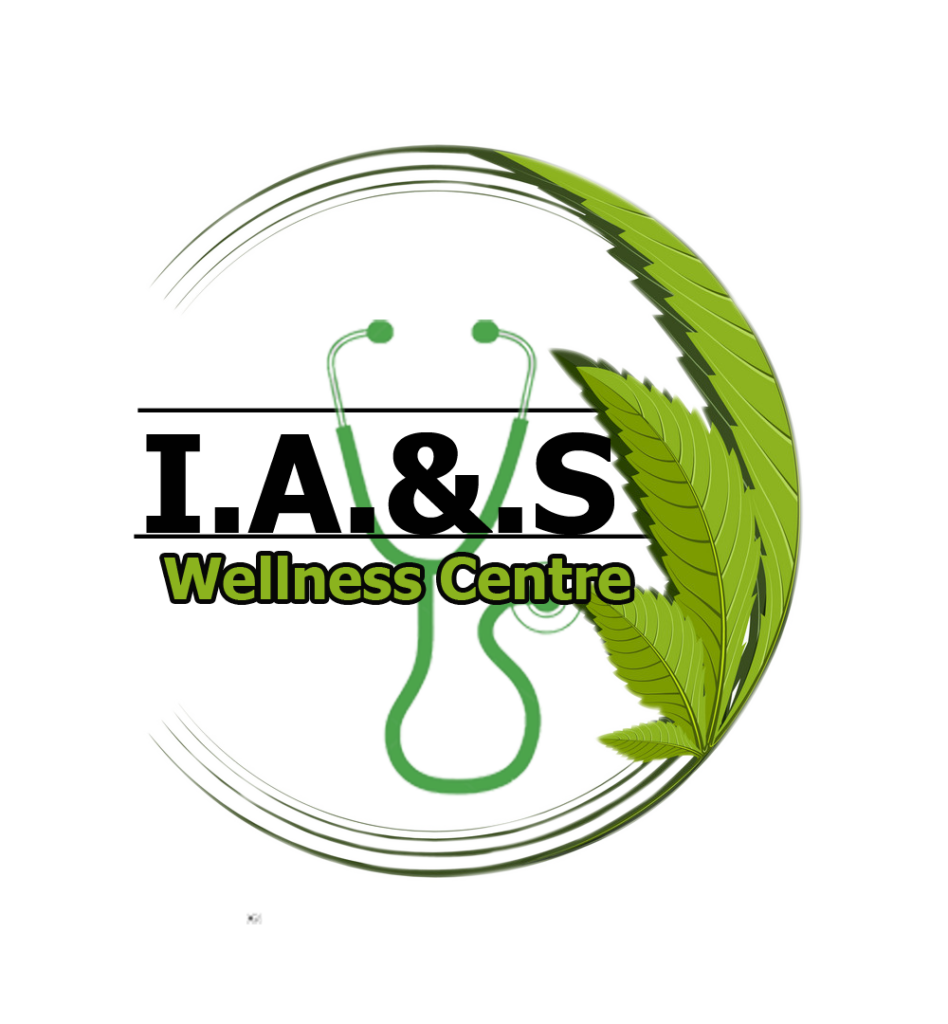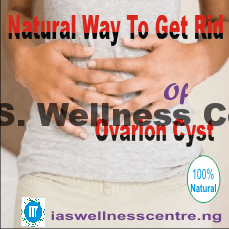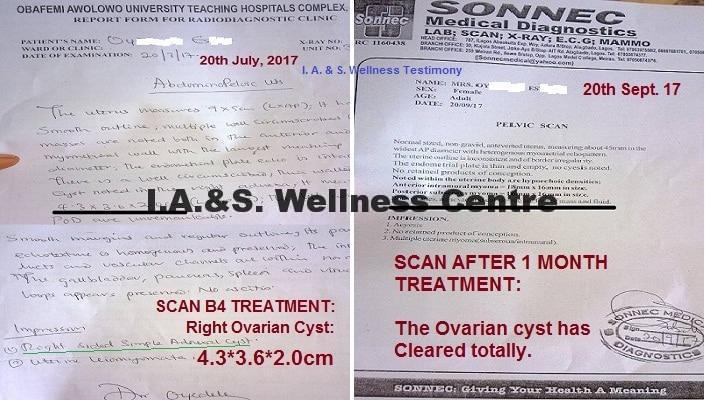OVERVIEW
1- What is Ovarian cyst?
2- Types of Ovarian Cysts
3- Six Facts About Ovarian Cysts
4- Signs and Symptoms
5- Diagnosing Ovarian Cysts
6- Natural Cure for Ovarian Cysts.
Welcome to Ovarian cyst clinic!
BE HAPPY YOU FOUND US!
Here we treat ovarian cyst naturally without surgery. Below are few proven scans report of some of those we have treated:
Case 1:
2nos of ovarian cysts cleared totally in 1 month of treatment
A. 2.9cm
B. 2.63cm
Attached are scan reports before treatment and scan after 1 month of treatment:
4.3*3.6cm OVARIAN CYST CLEARED IN 4 WEEKS.
BEFORE TREATMENT:
She had 4.3 by 3.6cm ovarian cyst in the right ovary.
AFTER 1 MONTH TREATMENT:
The right ovarian cyst CLEARED TOTALLY.
Below are scan results before treatment and after 1 months treatment.
Click here to see several other testimonies after taken our ovarian cyst treatment.
Let us discuss ovarian cyst and its natural treatment.
What is Ovarian cyst?
An ovarian cyst is an accumulation of fluid within an ovary that is surrounded by a thin “shell”..
Any ovarian follicle that is larger than approximately 2cm is an ovarian cyst. Ovarian cysts can range widely in size; from being as small as a pea to larger than an orange – in rare cases ovarian cysts can become so large that the woman looks pregnant.
The majority of ovarian cysts are benign (harmless).Ovarian cysts typically occur most frequently during a female’s reproductive years (childbearing years).
However, ovarian cysts may affect a woman of any age. In some cases, ovarian cysts cause pain and bleeding.
Types of ovarian cysts
1- Functional ovarian cysts
There are two types of functional ovarian cysts:
A) Follicular cysts
Follicular cysts are the most common type of ovarian cyst. A female human has two ovaries, small round organs which release an egg every month. The egg moves into the uterus (womb), where it can be fertilized by a male sperm. The egg is formed in the follicle, which contains fluid to protect the growing egg. When the egg is released, the follicle bursts.
In some cases, the follicle either does not shed its fluid and shrink after releasing the egg, or does not release an egg. The follicle swells with fluid, becoming a follicular ovarian cyst. Typically, one cyst appears at any one time and normally goes away within a few weeks (without treatment).
B) Luteal ovarian cysts
These are much less common. After the egg has been released it leaves tissue behind (corpus luteum). Luteal cysts can develop when the corpus luteum fills with blood. In most cases, this type of cyst goes away within a few months. However, it may sometimes split (rupture), causing sudden pain and internal bleeding.
2- Pathological cysts:
Pathological cysts – these are cysts that grow in the ovaries; they may be harmless (benign) or cancerous (malignant).
A) Dermoid cysts (cystic teratomas)
Dermoid cysts are the most common type of pathological cyst for women under 30 years of age. Cystadenomas are more common among women aged over 40 years.
Dermoid cysts (cystic teratomas)
A dermoid cyst a bizarre tumor, usually benign. This type of cyst develops from a totipotential germ cell, the cell can give rise to all orders of cells necessary to form mature tissues. Dermoid cysts contain hair, skin, bone and other tissues (sometimes even teeth). A totipotential germ cell can develop in any direction. They are formed from cells that make eggs.
B) Cystadenomas
Cystadenomas are ovarian cysts that develop from cells that cover the outer part of the ovary. Some are filled with a thick, mucous substance, while others contain a watery liquid. Rather than growing inside the ovary itself, cystadenomas are usually attached to the ovary by a stalk. By existing outside the ovary, they have the potential to grow considerably. Although they are rarely cancerous.
The following conditions may increase the risk of developing ovarian cysts:
(i) Endometriosis
Endometriosis is a condition in which cells that are normally found inside the uterus (endometrial cells) are found growing outside of the uterus. That is the lining of the inside of the uterus is found outside of it. Endometrial cells are the cells that shed every month during menstruation, and so endometriosis is most likely to affect women during their childbearing years. Women with this condition have a higher risk of developing ovarian cysts.
(ii) Polycystic ovarian syndrome (PCOS)
In this condition many small and harmless cysts develop on the ovaries, caused by a problem with hormone balance produced by the ovaries. People with PCOS have a higher risk of developing ovarian cysts.
6 FACTS ABOUT OVARIAN CYSTS
1- A cyst is a closed sac-like structure – an abnormal pocket of fluid, similar to a blister – that contains either liquid, gaseous, or semi-solid material..
2- A cyst is a closed sac-like structure like a blister. It consists of liquid, gaseous, or semi-solid substance.
3- A cyst is not a normal part of the tissue, it has a separate membrane. The outer section of a cyst is called the cyst wall.
4- Ovarian cyst size can range widely from being as small as a pea to larger than an orange.
5- Ovarian cysts are usually benign (harmless).
6- Ovarian cysts occur most frequently during a female’s reproductive years.
SIGNS AND SYMPTOMS OF AN OVARIAN CYSTS.
Even if there are symptoms, they alone cannot determine whether a patient has an ovarian cyst. There are several other conditions with similar signs and symptoms, including endometriosis, pelvic inflammatory disease, ectopic pregnancy or ovarian cancer. A ruptured ovarian cyst may present similar signs and symptoms to those of appendicitis or diverticulitis.
Signs and symptoms of an ovarian cyst may include:
1. Irregular menstruation – periods may also become painful, heavier or lighter than normal
2. A pain in the pelvis. This may be persistent pain or an intermittent dull ache that may spread to the lower back and thighs
3. Pelvic pain may appear just before menstruation begins
4. Pelvic pain may occur just before menstruation ends
5. Dyspareunia – pelvic pain during sexual intercourse. Some women may experience pain and discomfort in the abdomen after sex
6. Pain when passing a stool
7. Pressure on the bowels
8. Some pregnancy symptoms, including breast tenderness and nausea
9. Bloating, swelling, or heaviness in the abdomen
10. Problems fully emptying the bladder
11. Pressure on the rectum or bladder – the patient may have to go to the toilet more often, either to urinate or pass a stool
12. Hormonal abnormalities – in some rare cases the body produces abnormal amounts of hormones, resulting in changes in the way the breasts and body hair grow.
COMPLICATED CYST AND SYMPTOMS
Torsion – the stem of an ovary can become twisted if the cyst is growing on the stem, blocking the blood supply to the cyst and causing severe pain in the lower abdomen.
Bursting – if the ovarian cyst bursts, the patient will experience severe pain in the lower abdomen. If the cyst is infected pain will be worse. There may also be bleeding.
Cancer – in rare cases an ovarian cyst may be an early form of ovarian cancer.
DIAGNOSING OVARIAN CYSTS
The specialist will carry out a physical examination, focusing on possible signs and symptoms.
In determining a diagnosis, we need to know:
The shape of the cyst
The size of the cyst
The composition of the cyst – is it filled with solid, fluid or both? In most cases, fluid-filled cysts are not cancerous. Some may require further tests to find out.
Diagnostic test may also be ordered such as:
Ultrasound scan
NATURAL TREATMENT FOR OVARIAN CYST
Research into herbal medicines has discovered a natural way to dissolve ovarian cysts without having to under-gone surgery. The medicines form our ovarian cyst solution kit. The kit is 100% herbal/natural. The kit will dissolve/shrink the cysts irrespective of their sizes without surgery.
READ TESTIMONIES ON OVARIAN CYSTS SOLUTION KIT
 Click to read what people are saying about the ovarian cyst solution kit.
Click to read what people are saying about the ovarian cyst solution kit.
How Much Does This Treatment Kit Cost?
The prices are as follows:
1st BATCH COST OF OVARIAN CYSTS NATURAL TREATMENT
Category Cost (N)
A 50,000
B 80,000
C 100,000
The category you will go for in the 1st Batch of the treatment will depend on the following:
1-Numbers of the cysts
2- Sizes of the cysts
This can be known through pelvic scan. Go for scan then, forward your scan report to our email: [email protected] or Whatsapp (+234)-8038690104 to know the category that will be suitable/appropriate for you out of the categories stated above.
What differentiate the categories is the quantity of medicines. The quantity of natural medicines in C are more than the quantity in B. B is more than the quantity of medicines in A.
N.B: At the end of 1st batch treatment you will have to go for scan to confirm the 1st batch treatment, that scan report will determine whether there will be need for 2nd batch treatment or not.
If your ovarian cyst shrinked totally then there won’t be need for 2nd batch treatment, but if not totally shrinked after 1st batch treatment, they must have reasonably/significantly dissolved then that call for 2nd batch treatment to get the ovarian cyst shrinked totally. You will be amaze to found the ovarian cysts are gone after taking our Ovarian Cyst Solution Kit.
COST OF 2ND BATCH OVARIAN CYST TREATMENT
The 2nd batch treatment is in two categories:
Category A. N40,000
Category B. N60,000
The one you will go for out of the 2 categories depend on the scan report you will do after 1st batch treatment. It can’t be determined now and we can not say whether you will need it until after the you must have completed the 1st batch and do a scan.
Furthermore, at the end of the 2nd batch treatment you will also go for Ultrasound scan.
It is expected that by the time you finished the 1st batch you should get result and if the whole ovarian cysts did not dissolved totally at the end of 1st batch, it must have reasonably reduced then it is expected that there should be total result at the end of 2nd batch talking from experience from hundreds of cases already handled. Visit here to see some of the cases treated successfully without surgery.
Therefore, relax and be happy you found us.
ARE YOU OUTSIDE LAGOS OR OUTSIDE NIGERIA?
There are 2 options available in getting the treatment kit across to you anywhere you are
1st Option: Come to our office and pick up the treatment kit. People outside Lagos can send a representative in Lagos to pick it up for them.
2nd Option: We do ship the treatment kit to people nationwide to all states in Nigeria and all countries in the world.
Click here to see are evidences of deliveries. The treatments kits we have shipped to people both within Nigeria and outside Nigeria: www.iaswellnesscentre.ng/deliveries
*For shipping you will pay to our company’s account. Then we will ship it to you under 24-48 hours if you live in Nigeria.
*It takes 5-7 days for international delivery (we use EMS, DHL etc).
SHIPPING IS FREE OF CHARGE WITHIN NIGERIA.
INTERNATIONAL SHIPPING IS NOT TOTALLY FREE BUT ATTRACTS 50% DISCOUNT
OUR ADDRESS:
3rd Floor, 473, Lagos-Abeokuta Express Way, Old UBA Building Beside NNPC,, U-turn Bus Stop, Abule Egba, Lagos, Nigeria.
Mon – Friday (9.00 a.m. – 5.00 p.m.) Nigerian Time
Saturday (10.00 a.m. – 2.00 p.m.) Nigerian Time
Our Office is Close on Sunday but you can Whatsapp, Call, Email Us.
WHATSAPP: (+234)-8038690104
CALL: 08038690104 OR +234-8038690104
EMAIL: [email protected]
Website: www.iaswellnesscentre.ng
Email us: [email protected]
OTHER TREATMENT WE OFFER:
The following are some of the treatments we offer Alphabetically (A-Z):
- Abdominal pain Natural treatment
- Abnormal Vaginal bleeding Natural treatment
- Acquired Immunodeficiency Syndrome(AIDS) natural treatment
- Adhesion natural treatment
- Amenorrhea Natural treatment
- Anemia natural treatment
- Arteriosclerosis and Atherosclerosis Natural treatment
- Appendicitis Natural treatment without surgery
- Asthma Natural treatment
- Candidiasis Natural treatment
- Cancer Natural treatment
- Cervical Polyps Natural treatment
- Cholesterol Natural treatment
- Chlamydia Infection Natural treatment
- Fibroids Natural Treatment (without surgery)
- Female Infertility Natural treatment
- Fibrocystic Breast Natural Treatment
- Male infertility Natural treatment
- Menopause Natural treatment
- Mouth odor and Cancer Natural treatment
- PCOS (polycystic Ovary syndrome)Natural treatment
- Parkinson disease Natural Treatment
- Prostatitis Natural Cure
- Prostate Cancer Natural Treatment
- Polyps Natural Treatment
- Pelvic Inflammatory Disease Natural Treatment
- Sexually Transmitted Natural Treatment
- Stomach Yeast Infection Natural Treatment
- Toothache Natural Treatment
- Tuberculosis Natural Treatment
- Vericocele Natural Treatment (without surgery)
- Vaginitis Natural Treatment
- Vaginal Infection and Natural treatment etc




